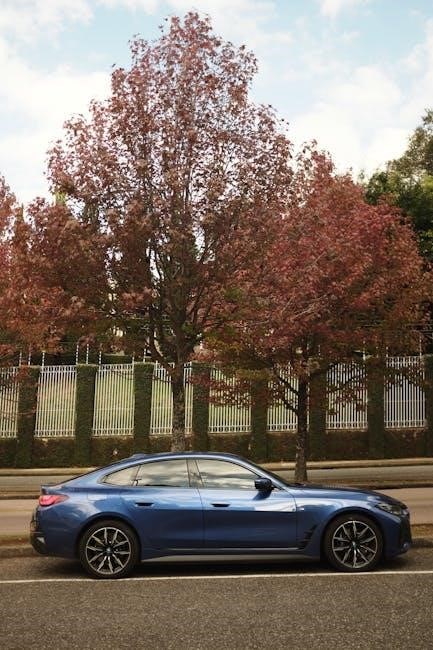Lenze Drive Fault Codes PDF: A Comprehensive Guide
This guide provides a detailed exploration of Lenze drive fault codes. It aims to assist users in understanding, diagnosing, and resolving common issues encountered with Lenze drives, ensuring optimal performance and minimizing downtime. Troubleshooting steps and resources are also available for effective problem-solving.
Lenze drives are integral components in various industrial applications, offering precise motor control and automation capabilities. These drives are known for their reliability and efficiency, playing a crucial role in optimizing processes across diverse sectors.
Understanding the fundamentals of Lenze drives is essential for effective operation and maintenance. These drives utilize advanced technology to regulate motor speed, torque, and direction, ensuring smooth and controlled movement in machinery.
Lenze offers a range of drives tailored to specific application needs, from simple variable frequency drives (VFDs) to sophisticated servo systems. Each drive type is designed with unique features and functionalities to meet the demands of different industrial environments.
A key aspect of working with Lenze drives is understanding their diagnostic capabilities. These drives are equipped with built-in monitoring systems that generate fault codes when issues arise. These fault codes serve as valuable indicators, helping users identify the root cause of problems and implement appropriate solutions.
This guide focuses on providing a comprehensive overview of common Lenze drive fault codes, offering insights into their meanings and troubleshooting steps. By understanding these codes, users can effectively diagnose and resolve issues, minimizing downtime and maximizing the lifespan of their Lenze drives.
Understanding Fault Codes in Lenze Drives

Fault codes in Lenze drives are essential diagnostic tools that provide valuable insights into the operational status of the drive system. These codes are generated when the drive detects an anomaly or malfunction, signaling the need for investigation and corrective action.
Each fault code corresponds to a specific issue, ranging from overcurrent and overvoltage to communication errors and temperature problems. Understanding the meaning of these codes is crucial for accurately diagnosing the problem and implementing the appropriate solution.
Lenze drives typically display fault codes on their control panels or through connected software interfaces. These codes often consist of a letter followed by a numerical value, such as “E01” for overcurrent or “E04” for drive overtemperature.
When a fault code appears, it is important to consult the Lenze drive’s documentation or a comprehensive fault code guide to determine the specific issue. The documentation will provide a detailed description of the fault, potential causes, and recommended troubleshooting steps.
Analyzing fault codes can help pinpoint the source of the problem, whether it is related to the motor, drive hardware, wiring, or external factors. By systematically addressing the potential causes associated with a particular fault code, users can efficiently resolve issues and restore the drive to normal operation.
This guide provides a detailed overview of common Lenze drive fault codes, offering explanations of their meanings and practical troubleshooting tips. By mastering the interpretation of these codes, users can enhance their ability to maintain and repair Lenze drives effectively.

Common Lenze Drive Fault Codes
This section details frequently encountered Lenze drive fault codes. Understanding these codes is crucial for quick diagnostics. Each code description includes possible causes and basic troubleshooting steps. Refer to the Lenze manual for detailed solutions and safety precautions before attempting any repairs.
Overcurrent/Overload Error (E01)
The E01 fault code in Lenze drives signifies an overcurrent or overload condition. This error indicates that the drive is experiencing excessive current draw, potentially damaging the drive or the connected motor. Several factors can contribute to this fault, including:
- Motor overload: The motor is drawing more current than its rated capacity due to excessive load or mechanical issues.
- Short circuit: A short circuit in the motor windings or cabling can cause a sudden surge in current.
- Incorrect motor parameters: Improperly configured motor parameters within the drive can lead to inaccurate current control.
- Acceleration/deceleration too rapid: Aggressive acceleration or deceleration settings can cause temporary overcurrent conditions.
- Drive malfunction: Internal component failure within the drive can also trigger this fault.
Troubleshooting the E01 error involves a systematic approach:
- Check motor load: Reduce the load on the motor to see if the fault clears.
- Inspect motor and cabling: Look for signs of damage or short circuits.
- Verify motor parameters: Ensure the motor parameters in the drive match the motor’s nameplate data.
- Adjust acceleration/deceleration: Increase the acceleration and deceleration times to reduce current spikes.
- Isolate the motor: Disconnect the motor from the drive and run the drive without a load. If the fault persists, the drive may be faulty.

Consult the Lenze drive manual for detailed troubleshooting steps and safety guidelines.
Engine Overheat Error (E02)
The E02 fault code on a Lenze drive typically signals an “Engine Overheat Error.” This indicates that the motor connected to the drive is experiencing excessive temperature, potentially leading to damage or reduced performance. It is crucial to address this fault promptly to prevent permanent motor failure. The causes of an E02 error can be varied, demanding thorough investigation:
- Excessive Load: The motor might be working beyond its capacity, leading to increased heat generation.
- Inadequate Ventilation: Poor airflow around the motor can trap heat, causing it to overheat.
- High Ambient Temperature: Elevated temperatures in the surrounding environment can contribute to motor overheating.
- Frequent Starts/Stops: Rapid and frequent motor cycling can generate significant heat.
- Faulty Motor Fan: A malfunctioning cooling fan on the motor can hinder heat dissipation.
To troubleshoot and resolve the E02 error, consider the following steps:
- Reduce Load: Decrease the load on the motor to alleviate stress and heat generation.
- Improve Ventilation: Ensure adequate airflow around the motor by removing obstructions or adding cooling fans.
- Monitor Ambient Temperature: Check the surrounding temperature and ensure it is within the motor’s operating range.
- Optimize Start/Stop Cycles: Minimize frequent starts and stops to reduce heat buildup.
- Inspect Motor Fan: Verify that the motor’s cooling fan is functioning correctly and replace it if necessary.

If the error persists after these steps, consult the Lenze drive manual or contact a qualified technician for further assistance. Ignoring this error can lead to severe motor damage.
Drive Overtemperature Error (E04)
The E04 fault code on a Lenze drive indicates a “Drive Overtemperature Error.” This means the internal temperature of the drive itself has exceeded its safe operating limit, potentially causing damage to the drive’s components. Addressing this error promptly is crucial to prevent permanent drive failure; Several factors can contribute to a drive overtemperature condition:
- High Ambient Temperature: Elevated temperatures in the environment surrounding the drive can hinder heat dissipation.
- Inadequate Ventilation: Insufficient airflow around the drive enclosure can trap heat, leading to overheating.
- Excessive Load: Operating the drive at or beyond its rated capacity can generate excessive heat.
- Faulty Cooling Fan: A malfunctioning fan inside the drive can prevent proper heat removal.
- Blocked Air Vents: Obstructed air vents on the drive enclosure can restrict airflow and cause overheating.
To troubleshoot and resolve the E04 error, consider the following steps:
- Reduce Ambient Temperature: Ensure the environment around the drive is within its specified operating temperature range.
- Improve Ventilation: Provide adequate airflow around the drive enclosure by removing obstructions or adding cooling fans.
- Reduce Load: Decrease the load on the drive to minimize heat generation.
- Inspect Cooling Fan: Verify that the drive’s internal cooling fan is functioning correctly and replace it if necessary.
- Check Air Vents: Ensure that the air vents on the drive enclosure are clear and unobstructed.

If the error persists after these steps, consult the Lenze drive manual or contact a qualified technician for further assistance. Continuing to operate the drive while it is overheating can lead to irreversible damage and costly repairs.
Motor Overvoltage Error (E06)
The E06 fault code on a Lenze drive signifies a “Motor Overvoltage Error.” This error indicates that the voltage being supplied to the motor exceeds the motor’s rated voltage capacity. This condition can lead to insulation breakdown within the motor windings, potentially causing permanent damage. Several factors can contribute to a motor overvoltage situation:
- Regenerative Braking: During rapid deceleration or braking, the motor can act as a generator, feeding voltage back into the drive. If this regenerative energy is not properly managed, it can cause an overvoltage condition.
- Incorrect Drive Settings: Improperly configured drive parameters, such as acceleration and deceleration rates, can exacerbate regenerative voltage spikes.
- Line Voltage Fluctuations: Sudden increases in the incoming line voltage can result in an overvoltage condition at the motor terminals.
- Long Motor Cables: Excessive cable length between the drive and motor can increase voltage reflections and contribute to overvoltage issues.
- Faulty Braking Resistor: If the braking resistor is not functioning correctly, it cannot dissipate the regenerative energy effectively.
To troubleshoot and resolve the E06 error, consider the following steps:
- Adjust Drive Parameters: Optimize acceleration and deceleration rates to minimize regenerative voltage spikes.
- Verify Line Voltage: Ensure that the incoming line voltage is within the acceptable range for the drive and motor.
- Shorten Motor Cables: Reduce the length of the motor cables to minimize voltage reflections.
- Inspect Braking Resistor: Verify that the braking resistor is properly sized and functioning correctly.
- Implement Braking Chopper: Consider using a braking chopper to effectively dissipate regenerative energy.
If the error persists after these steps, consult the Lenze drive manual or contact a qualified technician for further assistance. Ignoring a motor overvoltage condition can lead to costly motor repairs or replacements.
Drive Overvoltage Error (E08)

The E08 fault code in a Lenze drive indicates a “Drive Overvoltage Error.” This signifies that the DC bus voltage within the drive has exceeded its permissible limit. This condition can damage the drive’s internal components, potentially leading to drive failure. Several factors can contribute to a drive overvoltage situation:
- Regenerative Braking: Similar to motor overvoltage, regenerative braking can cause excess voltage to accumulate in the DC bus.
- High Line Voltage: An excessively high incoming line voltage can directly elevate the DC bus voltage beyond its limit.
- Inadequate Braking Resistor: If the braking resistor is undersized or malfunctioning, it cannot effectively dissipate regenerative energy.
- Faulty DC Bus Capacitors: Degraded or failing DC bus capacitors can lose their ability to absorb voltage fluctuations, leading to overvoltage.
- Rapid Deceleration: Abrupt deceleration of the motor can generate significant regenerative energy, overwhelming the drive’s capacity.
To troubleshoot and resolve the E08 error, consider the following steps:
- Verify Line Voltage: Ensure that the incoming line voltage is within the drive’s specified operating range.
- Inspect Braking Resistor: Check the braking resistor’s size and functionality. Replace if necessary.
- Adjust Deceleration Rate: Reduce the deceleration rate to minimize regenerative energy generation.
- Monitor DC Bus Voltage: Use a multimeter or drive monitoring software to observe the DC bus voltage during operation.
- Check DC Bus Capacitors: Inspect the DC bus capacitors for signs of bulging, leakage, or other damage. Replace if necessary.
If the error persists after these steps, it is crucial to consult the Lenze drive manual or contact a qualified technician. Continuing to operate the drive with an overvoltage condition can result in irreversible damage and costly repairs. Implement preventative measures to manage regenerative energy effectively and maintain a stable DC bus voltage.

Troubleshooting Lenze Drive Faults
Effective troubleshooting is essential for swiftly resolving Lenze drive faults and minimizing downtime. A systematic approach, combined with a clear understanding of fault codes, is crucial for success. Begin by carefully noting the specific fault code displayed on the drive’s interface. Consult the Lenze drive manual for a detailed description of the fault and its potential causes.
Next, visually inspect the drive and its associated components. Look for any signs of physical damage, such as burnt wires, loose connections, or overheating. Verify that all wiring connections are secure and properly terminated. Check the motor and load for any mechanical issues, such as excessive friction or binding.

Once the initial inspection is complete, proceed with electrical testing. Use a multimeter to check voltage levels, continuity, and resistance. Verify that the incoming line voltage is within the drive’s specified operating range. Test the motor windings for shorts or open circuits. Evaluate the functionality of any external braking resistors or filters.
If the fault persists after these steps, consider using Lenze’s diagnostic software to monitor drive parameters and identify anomalies. This software can provide valuable insights into the drive’s operation and help pinpoint the root cause of the problem. In some cases, resetting the drive to its factory default settings may resolve the issue.
For complex faults or persistent problems, it is advisable to contact a qualified Lenze technician or service center. They possess the expertise and specialized equipment necessary to diagnose and repair intricate drive issues effectively. Remember to document all troubleshooting steps taken and any relevant findings to facilitate the repair process.

Resources for Lenze Drive Fault Codes
When troubleshooting Lenze drive fault codes, having access to reliable resources is paramount for efficient problem-solving. The primary resource is the official Lenze documentation, which includes comprehensive manuals, datasheets, and application notes specific to your drive model. These documents provide detailed explanations of fault codes, troubleshooting procedures, and technical specifications.
Lenze’s website serves as a valuable hub for accessing these resources. Navigate to the support section, where you can search for your drive model and download relevant documentation. Additionally, Lenze often provides online training modules and webinars that cover common fault scenarios and troubleshooting techniques.
Beyond official documentation, online forums and communities dedicated to industrial automation can offer valuable insights. These platforms allow you to connect with other Lenze drive users, share experiences, and seek advice from experienced professionals. When posting questions, be sure to provide detailed information about your drive model, fault code, and the steps you have already taken.
Furthermore, consider reaching out to Lenze’s technical support team. They can provide expert guidance and assistance in diagnosing and resolving complex fault issues. When contacting support, have your drive model number and fault code readily available.
Lastly, explore third-party resources such as online knowledge bases and troubleshooting guides. These resources often compile information from various sources and present it in a user-friendly format. However, always verify the accuracy of information from unofficial sources against official Lenze documentation.
